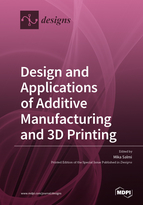Design and Applications of Additive Manufacturing and 3D Printing
A special issue of Designs (ISSN 2411-9660). This special issue belongs to the section "Smart Manufacturing System Design".
Deadline for manuscript submissions: closed (15 April 2019) | Viewed by 43328
Special Issue Editor
Interests: additive manufacturing (AM); 3D printing; design for additive manufacturing; processing materials with AM; medical applications
Special Issues, Collections and Topics in MDPI journals
Special Issue Information
Dear Colleagues,
The additive manufacturing (AM) business has grown in double digits in past years. The development of new materials and equipment has opened up new application possibilities, and equipment is quicker and cheaper using the new materials launched by vendors and material developers. AM has become more important for industry, but also for academics. Since AM offers more design freedom than any other manufacturing process, it provides designers with a new challenge to design better and more efficient products.
The objective of this Special Issue is to provide a forum for researchers and practitioners to exchange their latest achievements and to identify critical issues and challenges for future investigations of the design and applications of additive manufacturing.
Dr. Mika Salmi
Guest Editor
Manuscript Submission Information
Manuscripts should be submitted online at www.mdpi.com by registering and logging in to this website. Once you are registered, click here to go to the submission form. Manuscripts can be submitted until the deadline. All submissions that pass pre-check are peer-reviewed. Accepted papers will be published continuously in the journal (as soon as accepted) and will be listed together on the special issue website. Research articles, review articles as well as short communications are invited. For planned papers, a title and short abstract (about 100 words) can be sent to the Editorial Office for announcement on this website.
Submitted manuscripts should not have been published previously, nor be under consideration for publication elsewhere (except conference proceedings papers). All manuscripts are thoroughly refereed through a single-blind peer-review process. A guide for authors and other relevant information for submission of manuscripts is available on the Instructions for Authors page. Designs is an international peer-reviewed open access semimonthly journal published by MDPI.
Please visit the Instructions for Authors page before submitting a manuscript. The Article Processing Charge (APC) for publication in this open access journal is 1600 CHF (Swiss Francs). Submitted papers should be well formatted and use good English. Authors may use MDPI's English editing service prior to publication or during author revisions.
Keywords
- Design for additive manufacturing
- Industrial applications of additive manufacturing
- Medical applications of additive manufacturing
- AM materials and equipment development
- AM processes
- Topology optimization





